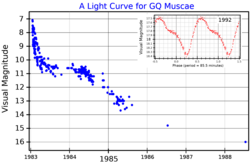GQ Muscae
Appearance
 A visual band light curve for GQ Muscae. The main plot shows the decline from the 1983 eruption, plotted with data from the AAVSO,[1] Whitelock et al.[2] and Liller.[3] The inset plot (adapted from Narloch et al.[4]) shows the post-eruption variability seen in 1992. | |
| Observation data Epoch J2000 Equinox J2000 | |
|---|---|
| Constellation | Musca |
| Right ascension | 11h 52m 02.4285s[5] |
| Declination | −67° 12′ 20.9911″[5] |
| Apparent magnitude (V) | 7.2 Max. 21 Min.[6] |
| Characteristics | |
| Variable type | Nova[6] |
| Astrometry | |
| Proper motion (μ) | RA: −5.056±0.451[5] mas/yr Dec.: 1.193±0.324[5] mas/yr |
| Parallax (π) | 0.4702 ± 0.2193 mas[5] |
| Distance | 2480+3780 −300[6] pc |
| Other designations | |
| Database references | |
| SIMBAD | data |
GQ Muscae, also known as Nova Muscae 1983 is a nova in the constellation Musca, which was discovered by William Liller at 03:20 UT on 18 January 1983.[8] At the time of its discovery it was a magnitude ≈7.2 object, and it subsequently faded.[3][9]
GQ Muscae is a binary star system composed of a white dwarf and small star, the donor star, that is about 10% as massive as the Sun. The two orbit each other every 1.4 hours. The white dwarf accumulates material from the donor star until a runaway nuclear thermonuclear reaction erupts, as it did in 1983.[9] GQ Muscae was the first nova from which X-rays were detected.[10]
References
[edit]- ^ "Download Data". aavso.org. AAVSO. Retrieved 1 October 2021.
- ^ Whitelock, P. A.; Carter, B. S.; Feast, M. W.; Glass, I. S.; Laney, D.; Menzies, J. W.; Walsh, J.; Williams, P. M. (November 1984). "Infrared and optical observations of Nova Mus 1983". Monthly Notices of the Royal Astronomical Society. 211 (2): 421–432. Bibcode:1984MNRAS.211..421W. doi:10.1093/mnras/211.2.421.
- ^ a b Liller, William (1990). Cambridge Astronomy Guide. Cambridge, United Kingdom: CUP Archive. p. 105. ISBN 0-521-39915-7.
- ^ Narloch, W.; Kaluzny, J.; Krzeminski, W.; Pych, W.; Rozyczka, M.; Shectman, S.; Thompson, I. B.; Tomov, T. (January 2014). "New Observations of the Old Magnetic Nova GQ Muscae". Baltic Astronomy. 23: 1–7. arXiv:1401.7177. Bibcode:2014BaltA..23....1N. doi:10.1515/astro-2017-0168. S2CID 119291924. Retrieved 30 January 2022.
- ^ a b c d e Brown, A. G. A.; et al. (Gaia collaboration) (August 2018). "Gaia Data Release 2: Summary of the contents and survey properties". Astronomy & Astrophysics. 616. A1. arXiv:1804.09365. Bibcode:2018A&A...616A...1G. doi:10.1051/0004-6361/201833051. Gaia DR2 record for this source at VizieR.
- ^ a b c Schaefer, Bradley E. (2018). "The distances to Novae as seen by Gaia". Monthly Notices of the Royal Astronomical Society. 481 (3): 3033–3051. arXiv:1809.00180. Bibcode:2018MNRAS.481.3033S. doi:10.1093/mnras/sty2388. S2CID 118925493.
- ^ "GQ Muscae". SIMBAD. Centre de données astronomiques de Strasbourg. Retrieved 2019-08-19.
- ^ Marsden, Brian G. (20 January 1983). "Nova Muscae 1983". International Astronomical Union Circular (3764). Retrieved 30 January 2022.
- ^ a b Hachisu, Izumi; Kato, Mariko; Cassatella, Angelo (2008). "A Universal Decline Law of Classical Novae. III. GQ Muscae 1983". The Astrophysical Journal. 687 (2): 1236–52. arXiv:0806.4253. Bibcode:2008ApJ...687.1236H. doi:10.1086/591415. S2CID 50476380.
- ^ Duerbeck, H.W. (2009). "New Stars and Telescopes: Nova Research in the Last Four Centuries" (PDF). Astronomische Nachrichten. 330 (6): 568–73. Bibcode:2009AN....330..568D. doi:10.1002/asna.200911218. Archived from the original (PDF) on 2015-09-24. Retrieved 2014-03-09.
